 | | | Switch to: Europe, USA, New Zealand, Antarctica Credit: NOAA/Ovation  Planetary K-index Planetary K-index
Now: Kp= 0.67 quiet
24-hr max: Kp= 3.33 quiet
explanation | more data
Interplanetary Mag. Field
Btotal: 8.54 nT
Bz: 6.71 nT north
more data: ACE, DSCOVR
Updated: Today at 1147 UT  Coronal Holes: 14 Feb 24 Coronal Holes: 14 Feb 24 
There are no significant coronal holes on the Earthside of the sun. Credit: SDO/AIA  Polar Stratospheric Clouds
Colorful Type II polar stratospheric clouds (PSC) form when the temperature in the stratosphere drops to a staggeringly low -85C. NASA's MERRA-2 climate model predicts when the air up there is cold enough: 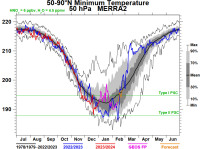
On Feb. 14, 2024, the Arctic stratosphere is a few degrees too warm for Type II polar stratospheric clouds. | more data. Noctilucent Clouds
The southern season for NLCs is underway. The first clouds were detected inside the Antarctic Circle on Dec. 4, 2023, by the NOAA 21 satellite. An instrument onboard NOAA 21 (OMPS LP) is able to detect NLCs (also known as "polar mesospheric clouds" or PMCs). For the rest of the season, daily maps from NOAA 21 will be presented here:
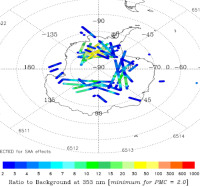
Updated: Feb 14, 2024
Each dot is a detected cloud. As the season progresses, these dots will multiply in number and shift in hue from blue to red as the brightness of the clouds intensifies.
 SPACE WEATHER
NOAA Forecasts | | Updated at: 2024 Feb 14 2200 UTC FLARE | 0-24 hr | 24-48 hr | CLASS M | 55 % | 55 % | CLASS X | 15 % | 15 % |  Geomagnetic Storms: Geomagnetic Storms:
Probabilities for significant disturbances in Earth's magnetic field are given for three activity levels: active, minor storm, severe storm Updated at: 2024 Feb 14 2200 UTC Mid-latitudes | 0-24 hr | 24-48 hr | ACTIVE | 20 % | 10 % | MINOR | 05 % | 01 % | SEVERE | 01 % | 01 % | High latitudes | 0-24 hr | 24-48 hr | ACTIVE | 15 % | 15 % | MINOR | 30 % | 20 % | SEVERE | 30 % | 20 % | | | |  | | | | | | | | | | | This is an AI Free Zone! Text created by ChatGPT and other Large Language Models is spreading rapidly across the Internet. It's well-written, artificial, frequently inaccurate. If you find a mistake on Spaceweather.com, rest assured it was made by a real human being. | | | WAITING FOR THE CMEs: Multiple CMEs expected to hit Earth's magnetic field on Feb. 13th either missed or they are running late. NOAA is betting on the latter. The official forecast calls for minor G1-class geomagnetic storms on Feb 14th in response to the overdue CMEs. CME Impact alerts: SMS Text SOLAR RADIATION STORM UPDATE: For the third day in a row, energetic protons from the sun are raining down on Earth. However, the storm is subsiding. It is now a minor S1-class event. The storm's one lingering effect is a polar cap absorption event (PCA): 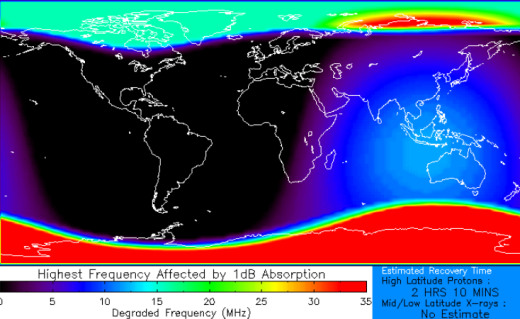
Red zones in this global map show where shortwave radio transmissions are being absorbed. Frequencies below 15 MHz are almost completely blacked out, while anything below 35 MHz is being attentuated, at least a little. This is a direct result of the ongoing solar radiation storm. Earth's magnetic field funnels the proton rain toward the poles where their ionizing effect causes the absorption of shortwave radio. The south pole is more strongly effected than the north pole because it is now summer in the south; that side of Earth is tilted into the radiation storm. The absorption event could last for days; you can can monitor its progress here. Realtime Space Weather Photo Gallery
Free: Spaceweather.com Newsletter FARSIDE HALO CME: Something exploded on the farside of the sun today. We know because it threw a halo CME into space. The Solar and Heliospheric Observatory (SOHO) caught the cloud leaving the sun just after 0600 UT: 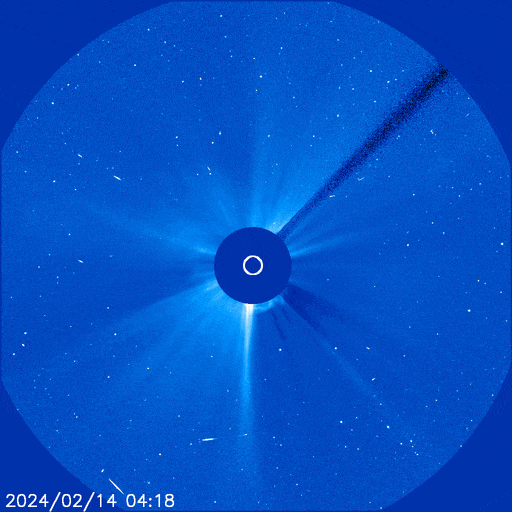
This CME will not hit Earth. Instead, Mercury and Mars are in the line of fire. A NASA model of the CME indicates that it has already hit Mercury and it will reach Mars on Feb. 17th. CMEs striking Mercury can ignite X-ray auroras at ground level on that planet's rocky surface. CMEs hitting Mars cause a completely different kind of auroras, which shine at UV wavelengths high in the tops of the Red Planet's magnetic umbrellas. Realtime Space Weather Photo Gallery
Free: Spaceweather.com Newsletter 18K GOLD "LOVE YOU TO THE MOON" LOCKET: This is a very special locket. It's heart-shaped, plated with 18K gold, and we will fly it again during this year's total eclipse of the sun. Keep reading... On Jan. 26, 2024, the students of Earth to Sky Calculus launched this locket to the stratosphere onboard a cosmic ray research balloon. At the apex of the flight, it floated 111,535 feet above the Sierra Nevada mountains of central California: 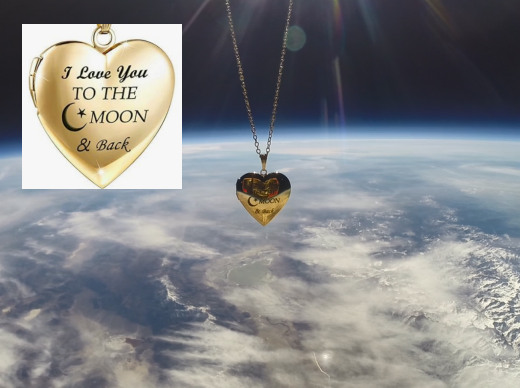
Buy it now for $149.95, and we'll fly it again--FOR FREE--during the total solar eclipse on April 8, 2024. The students will be launching multiple balloons from the path of totality in Texas. Your pendant will go along for the ride, touching the shadow of the Moon at the edge of space. (Simply type "FLY IT AGAIN" in the comments box at checkout.) The locket, which opens to hold a personal photo or other small item, comes with a greeting card showing the jewelry in flight and telling the story of its journey to the edge of space.
Far Out Gifts: Earth to Sky Store
All sales support hands-on STEM education
Realtime Aurora Photo Gallery
Free: Spaceweather.com Newsletter
Realtime Comet Photo Gallery
Free: Spaceweather.com Newsletter Every night, a network of NASA all-sky cameras scans the skies above the United States for meteoritic fireballs. Automated software maintained by NASA's Meteoroid Environment Office calculates their orbits, velocity, penetration depth in Earth's atmosphere and many other characteristics. Daily results are presented here on Spaceweather.com. On Feb 14, 2024, the network reported 8 fireballs.
(8 sporadics) 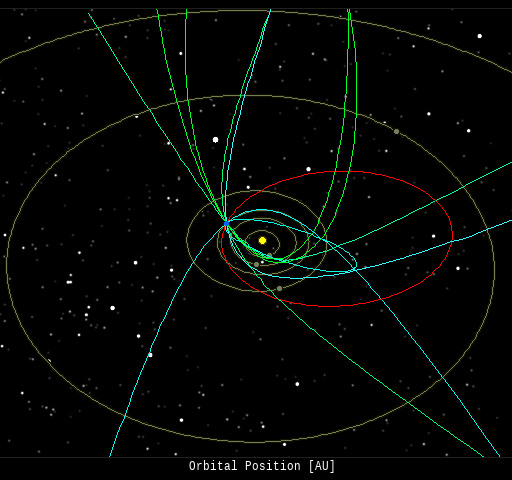 In this diagram of the inner solar system, all of the fireball orbits intersect at a single point--Earth. The orbits are color-coded by velocity, from slow (red) to fast (blue). [Larger image] [movies] Potentially Hazardous Asteroids ( PHAs) are space rocks larger than approximately 100m that can come closer to Earth than 0.05 AU. None of the known PHAs is on a collision course with our planet, although astronomers are finding new ones all the time. On February 14, 2024 there were 2349 potentially hazardous asteroids.
 | Recent & Upcoming Earth-asteroid encounters: | Asteroid | Date(UT) | Miss Distance | Velocity (km/s) | Diameter (m) | | 2024 CJ1 | 2024-Feb-09 | 1 LD | 7.6 | 7 | | 2024 BH | 2024-Feb-10 | 18.4 LD | 8.1 | 70 | | 2024 CV1 | 2024-Feb-10 | 5.2 LD | 3.1 | 7 | | 2024 CH4 | 2024-Feb-11 | 0.3 LD | 24 | 10 | | 2024 CZ3 | 2024-Feb-11 | 5.1 LD | 9.3 | 38 | | 2024 CU | 2024-Feb-11 | 1.8 LD | 7.2 | 20 | | 2024 CC4 | 2024-Feb-12 | 4.6 LD | 7.8 | 11 | | 2024 CY1 | 2024-Feb-12 | 0.3 LD | 14.5 | 5 | | 2020 DK | 2024-Feb-12 | 8.9 LD | 9.9 | 22 | | 2024 CD4 | 2024-Feb-13 | 4.4 LD | 6.4 | 16 | | 2024 CB1 | 2024-Feb-13 | 3.8 LD | 17.5 | 51 | | 2024 CD1 | 2024-Feb-14 | 9.9 LD | 12.3 | 19 | | 2024 CK3 | 2024-Feb-14 | 17.6 LD | 7.8 | 41 | | 2024 CL1 | 2024-Feb-14 | 3.4 LD | 14.3 | 25 | | 2024 BR4 | 2024-Feb-14 | 12 LD | 12.5 | 182 | | 2024 CU1 | 2024-Feb-14 | 1.5 LD | 10.8 | 16 | | 2024 CE1 | 2024-Feb-15 | 11.1 LD | 9.2 | 27 | | 2024 CN3 | 2024-Feb-15 | 15.7 LD | 9.2 | 20 | | 2024 CY | 2024-Feb-15 | 20 LD | 1.8 | 29 | | 2024 CE4 | 2024-Feb-15 | 2.5 LD | 18.7 | 13 | | 2024 CP4 | 2024-Feb-16 | 5.7 LD | 11.6 | 31 | | 2024 AO | 2024-Feb-16 | 9.3 LD | 7.3 | 51 | | 2024 CA2 | 2024-Feb-16 | 11.8 LD | 10.7 | 48 | | 2024 BC8 | 2024-Feb-18 | 6.2 LD | 10.5 | 30 | | 2024 CH2 | 2024-Feb-18 | 5.7 LD | 9.6 | 23 | | 2024 CL3 | 2024-Feb-23 | 9.3 LD | 4.2 | 20 | | 2019 DA1 | 2024-Mar-03 | 14.6 LD | 13.4 | 22 | | 2015 FM34 | 2024-Mar-12 | 19.4 LD | 11.1 | 113 | | 2020 FU | 2024-Mar-15 | 14.9 LD | 15.5 | 19 | | 2020 FD | 2024-Mar-18 | 4.5 LD | 15.1 | 10 | | 2024 BD7 | 2024-Mar-19 | 18.8 LD | 10.1 | 140 | | 2019 CJ | 2024-Mar-24 | 12.4 LD | 4.4 | 30 | | 2021 CF6 | 2024-Mar-25 | 14.5 LD | 8.3 | 63 | | 2023 RO49 | 2024-Mar-29 | 14.1 LD | 4.3 | 45 | | 2015 MB54 | 2024-Mar-30 | 11.7 LD | 3.8 | 55 | | 2018 CC14 | 2024-Apr-03 | 19.6 LD | 8.9 | 114 | | 2023 GC2 | 2024-Apr-04 | 8.7 LD | 5.7 | 12 | | 2005 FG | 2024-Apr-08 | 18.4 LD | 5.5 | 59 | | 2020 BP13 | 2024-Apr-09 | 15.2 LD | 6.8 | 204 | | 2021 RJ19 | 2024-Apr-12 | 19.6 LD | 11.4 | 25 | | 2021 GQ5 | 2024-Apr-13 | 8.8 LD | 7.5 | 7 | Notes: LD means "Lunar Distance." 1 LD = 384,401 km, the distance between Earth and the Moon. 1 LD also equals 0.00256 AU. | | Cosmic Rays in the Atmosphere | SPACE WEATHER BALLOON DATA: Almost once a week, Spaceweather.com and the students of Earth to Sky Calculus fly space weather balloons to the stratosphere over California. These balloons are equipped with sensors that detect secondary cosmic rays, a form of radiation from space that can penetrate all the way down to Earth's surface. Our monitoring program has been underway without interruption for 7 years, resulting in a unique dataset of in situ atmospheric measurements. Latest results (July 2022): Atmospheric radiation is decreasing in 2022. Our latest measurements in July 2022 registered a 6-year low: 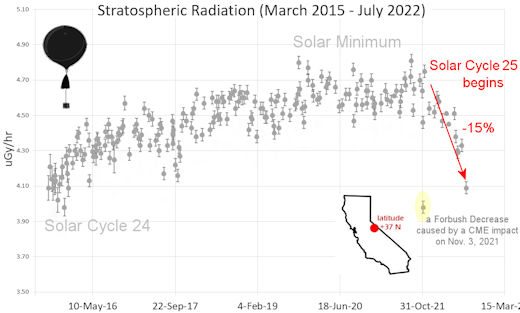
What's going on? Ironically, the radiation drop is caused by increasing solar activity. Solar Cycle 25 has roared to life faster than forecasters expected. The sun's strengthening and increasingly tangled magnetic field repels cosmic rays from deep space. In addition, solar coronal mass ejections (CMEs) sweep aside cosmic rays, causing sharp reductions called "Forbush Decreases." The two effects blend together to bring daily radiation levels down. .Who cares? Cosmic rays are a surprisingly "down to Earth" form of space weather. They can alter the chemistry of the atmosphere, trigger lightning, and penetrate commercial airplanes. According to a study from the Harvard T.H. Chan school of public health, crews of aircraft have higher rates of cancer than the general population. The researchers listed cosmic rays, irregular sleep habits, and chemical contaminants as leading risk factors. A number of controversial studies (#1, #2, #3, #4) go even further, linking cosmic rays with cardiac arrhythmias and sudden cardiac death. Technical notes: The radiation sensors onboard our helium balloons detect X-rays and gamma-rays in the energy range 10 keV to 20 MeV. These energies span the range of medical X-ray machines and airport security scanners. Data points in the graph labeled "Stratospheric Radiation" correspond to the peak of the Regener-Pfotzer maximum, which lies about 67,000 feet above central California. When cosmic rays crash into Earth's atmosphere, they produce a spray of secondary particles that is most intense at the entrance to the stratosphere. Physicists Eric Regener and Georg Pfotzer discovered the maximum using balloons in the 1930s and it is what we are measuring today. | | The official U.S. government space weather bureau | | | The first place to look for information about sundogs, pillars, rainbows and related phenomena. | | | Researchers call it a "Hubble for the sun." SDO is the most advanced solar observatory ever. | | | 3D views of the sun from NASA's Solar and Terrestrial Relations Observatory | | | Realtime and archival images of the Sun from SOHO. | | | information about sunspots based on the latest NOAA/USAF Active Region Summary | | | current counts of failed and deployed Starlink satellites from Jonathan's Space Page | | | Authoritative predictions of space junk and satellite re-entries | | | from the NOAA Space Environment Center | | | fun to read, but should be taken with a grain of salt! Forecasts looking ahead more than a few days are often wrong. | | | from the NOAA Space Environment Center | | | the underlying science of space weather |  | When looking for casinos to play online when the weather is bad, you can try the SkyCity Online Casino if you are located in New Zealand. If you are not from NZ you can try the Swedish page Svenska casino online to find suitable games, check out svenskacasinoonline.net. Always check your local laws before playing with real money.. |  | BestCSGOGambling is the best site for everything related to CSGO gambling on the web | | | These links help Spaceweather.com stay online. Thank you to our supporters! | | | | | | | | |  | |  |   | ©2021 Spaceweather.com. All rights reserved. This site is penned daily by Dr. Tony Phillips. | |

